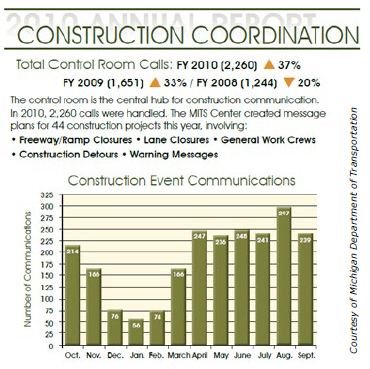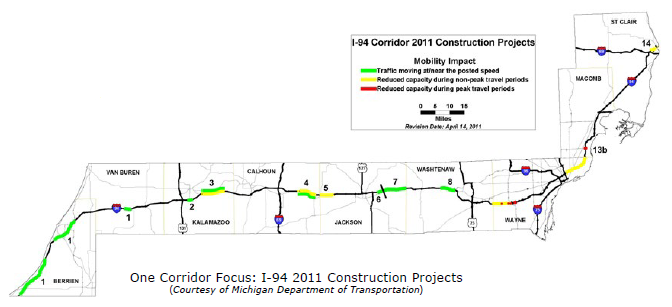Fact Sheet 19 - Work Zone Corridor Management in Michigan
Download the Printable Version (PDF, 259 KB)
PDF files can be viewed with the Acrobat® Reader®.

Summer 2013
Through their "One Corridor Focus" initiative, the Michigan Department of Transportation (MDOT) manages work zones along key corridors as a single unit rather than discrete projects, enabling MDOT to better mitigate travel time delay during construction and maintenance activities. The One Corridor Focus began as a result of lengthy travel delays due to 19 concurrent reconstruction projects on Interstate 94 (I–94) in 2010, a corridor that stretches 250 miles through three MDOT regions. MDOT uses several methods to manage and coordinate road projects along key corridors, including establishing goals and measuring performance during construction, applying consistent work zone standards, and coordinating with stakeholders throughout planning and construction.

Corridor Performance Measures.
Travel time delay is a key indicator of mobility performance along a corridor. Through the Michigan Work Zone Safety and Mobility Policy, MDOT had established a performance standard of no more than 10 minutes of delay for an individual project. However, MDOT realized that when there are several projects along a corridor, the total delay could quickly become unacceptable to motorists even if each project met the 10-minute delay threshold. To limit the overall delay along a corridor, MDOT determines a total amount of acceptable travel delay in minutes across all the work zones in the corridor. MDOT measures travel delay using speed data collected by their traffic management system. MDOT is able to calculate average delay per vehicle by segment, percentage of traffic operating at posted speeds, and minutes of travel time delay during peak and nonpeak travel times, by segment. To minimize travel times, MDOT applies consistent work zone standards along the corridor and coordinates project schedules and lane closures among corridor stakeholders.
Consistent Work Zone Standards.
By applying consistent work zone standards along a corridor, MDOT increases the opportunity for improved driver understanding of traffic control, which better meets driver expectations and leads to improved mobility and safety. For example, when possible, MDOT closes the left lane first and merges all drivers to the right. Drivers are subsequently shifted to the left if work will be in the right lane. Consistently having drivers merge to the right at a lane drop can create a common understanding of what lane will be closing and how to merge effectively throughout the corridor. Another example of consistent standards is using the same minimum lane width (e.g., 11 feet) for all work zones along a corridor. MDOT anticipates that consistent minimum lane widths will reduce side swipe crashes while maintaining reasonable work zone speeds. Consistent standards also include guidelines for traffic incident management coordination and response in work zones along a corridor.
Coordination with Stakeholders.
The I-94 Construction Team has weekly conference calls with MDOT, its contractors and consultants, and the operations centers to discuss:
Based on these calls, the Construction Team has developed corridor-level standards that include:
|
MDOT coordinates with relevant agencies and stakeholders to plan for, monitor, and resolve work zone-related delays or issues. Stakeholders can include regional, local, and metropolitan agency staff, adjacent State DOTs, contractor representatives, Toll Authority personnel, and fire/police representatives. Through project coordination meetings and construction coordination meetings, MDOT can optimize some closures by combining various activities (e.g., freeway patching, sign removal, and bridge maintenance) into one closure. In conjunction with operations centers in Detroit and Grand Rapids, the Statewide Traffic Operations Center provides 24/7 construction monitoring and coordination, handles the majority of statewide traffic notices, and posts messages on dynamic signs.
Applying the One Corridor Focus: Interstate 94
I-94 is part of a multi-state demonstration corridor identified by the Great Lakes Regional Transportation Operations Coalition (GLRTOC) to pilot coordination efforts on work zones and metropolitan issues. The GLRTOC was established to work together to improve crossregional transportation operations in support of regional economic competitiveness and quality of life in Illinois, Indiana, Michigan, Minnesota, Wisconsin, and Ontario, Canada. In conjunction with the GLRTOC efforts, I-94 was an ideal location to apply the One Corridor Focus concept. For the I-94 corridor, MDOT established a construction team that consisted of traffic engineers, construction engineers, communication representatives, and traffic operations center representatives from relevant agencies along the corridor. The I-94 Construction Team, which also included members of the GLRTOC, established a performance measure for travel time delay through work zones along the entire I-94 corridor, with three segments separated at major entry or departure points. The segment limits were purposely set to include two of the three regions so that collaboration was required.

| I-94 Corridor Segment | Maximum Allowed Delay per Vehicle |
2011 Measured Delay per Vehicle |
|---|---|---|
| Indiana border to I-69 | 15 min | 2.8 – 7.2 min |
| I–69 to I–75 | 15 min | 3.2 – 8.5 min |
| I-75 to Canada border | 10 min | 0.8 – 3.7 min |
To Learn more, contact:
Hilary Owen
Michigan DOT
517-636-0290
OwenH2@michigan.gov
Dave Morena
FHWA Michigan Division
517-702-1836
david.morena@dot.gov
Tracy Scriba
Federal Highway Administration
202-366-0855
Tracy.Scriba@dot.gov

Publication No. FHWA-HOP-13-052
